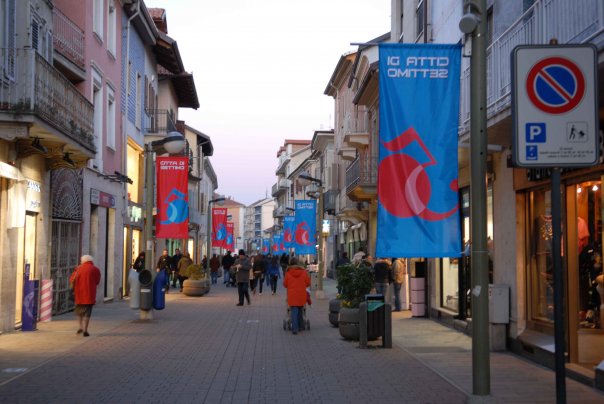OK, after a few days out time to return to my Giro, which you may remember had just come off two back to back mountain stages, the first to Mangàrt, the second over five mountains, the last of which was Fedaia (Fedaia!!!) and included the Cima Coppi.
Stage 14: Bolzano-Bozan - Merano 2000, 215km
Climbs:
Alpe di Siusi (cat.1) 24,9km @ 6,1%
Alpe di Rodengo (cat.1) 10,8km @ 8,2%
Passo di Monte Giovo (cat.1) 15,0km @ 7,5%
Merano 2000 (cat.1) 16,0km @ 8,2%
Yes, here's the final stages of our trip through the Dolomites, and the last day before the second rest day. It's a Sunday, so a big stage is expected. I did mention that I was aware three consecutive big mountain stages would likely result in conservative racing earlier by riders unwilling to chance too much ahead of the last of these, but that was why I made the first of the three a fairly uncomplicated stage with a monolithic final climb that would open up gaps on its own, and the second of the three with the Cima Coppi as a prestigious prize ensuring racing ahead of the final climb, and with the final climb being Fedaia with its final 5km at over 11% meaning there's a perfect springboard for attacking. Today, we finish it off with another monster MTF.
The day's action starts in Bolzano/Bozen, the capital of Südtirol and - due mostly to migration of Italian workers in the 1920s and 1930s - one of very few Südtirol municipalities where Italian is the dominant language. It is (thanks wikipedia!) the city ranked as having the highest quality of life in Italy. But then, if you can guarantee the Giro nearby every May, and the XC skiing and biathlon World Cups nearby every winter along with literally hundreds of options for both cycling and cross-country skiing nearby, you can understand the reasons for this.
The riders are almost immediately sent into the first climb of the day (the start of it is cut off by tracks4bikers). Alpe di Siusi is famed for its
cross-country skiing facilities, and it is only recently that the venue has branched out into cycling, hosting a mountaintop finish in the 2009 Giro. That was in a
short stage where the climb was the only major one of the day and so its GC impact was limited. It's a
two-stepped climb with a long period of false flat in the middle, however the final few kilometres average 8%, so we will likely see a strong break get away.
In comparison to yesterday's stage, however, the climbs are quite spread out today, with sizable gaps between them to enable the break to consolidate or for the peloton to apply pressure to the fugitives. The descent from Siusi is very, very long and gradual (over 30km), then there's a brief period of flat, then a small climb that would probably be categorised in a flatter stage (it's actually about 5km at 5-6%) that leads us in to the next climb. Rodenecker Alm, known in Italian as
Alpe di Rodengo, is another Langlaufgebiet which is little known to the Giro. Its northern side is
11km @ 8,8%, which is a pretty damn brutal climb. But we're not climbing this, no. We're climbing the southern side, which at 10,8km @ 8,2% you may consider seems by the numbers to be slightly weaker. But the numbers lie. You see, from Lüsen, the climb is a three-stepped monster with two summits, although unlike other double-summit climbs like Fumanya-Pradell in Spain or Peyresourde-Peyragudes in France this time the second climb is easier.
Here's the profile which, unlike the climbbybike profile of this side, actually goes all the way to the summit at Parkplatz Zumis rather than stopping at the second flat. For those of you wondering, that first 6km is at 10,6%.
After this, the descent is steep and technical (you've seen the profile), back into the Pustertal before we head into some valley roads (about 30km of them) before the intermediate sprint in
Vipiteno-Sterzing. Here, the action ramps up properly, because this time if there are attacks, I don't think that the big guns will be able to afford to rely on teammates coming back and pacing them in the valley roads. Passo di Monte Giovo (Jaufenpass) is one of those
classic, sweepingmountain roads,
switchback after switchback punishing the riders over 15km at 7,5%. The summit here is with 54km remaining, and then there's an even longer, steep and technical descent (although the roads are wider and more comfortable than the Rodengo descent). There are a few kilometres of valley roads, but these are downhill false flat into the city of
Meran/Merano, where we start the final ascent.
Merano 2000 is a
famous ski resort that overlooks Meran, and is mostly connected to it by a cable car. It is also linked to it by a long, winding and very steep road (as you can see from
the profile, it's an absolute brute, especially when you consider almost all of that yellow is at 9 or 10%!!!), which has bizarrely only been used in Il Giro once - all the way back in 1988, the day after the infamous Bormio stage over the Gavia in a snowstorm when Andy Hampsten put in the performance that won the Giro - they climbed the Stelvio early, but then it was a long and flat run in before
the one-climb finish at Meran 2000. Now, admittedly, this climb is tough enough that it could stand alone as a Unipublic stage, but as you are probably well aware by now, I am not Javier Guillén. So the riders have a well-earnt rest day tomorrow, they can have their pick of Bolzano, Trento, Merano, Vicenza or Verona, because there's a week still to go and they need to rest up after three straight mountain stages.
Bolzano:
Merano 2000:







































